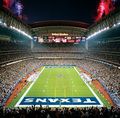In proposing a hotel and car rental tax, political boosters of a publicly financed stadium for the Minnesota Vikings aren’t breaking new ground. The two taxes are the most-often-used methods of public financing in NFL stadiums. Only one other team — Seattle — uses lottery revenue. The Vikings’ 33.3% contribution to the new stadium is about in line with most other cities.
In many cases, county resources are the most often used public financing, rather than state money.
Here’s a rundown of how recent NFL stadiums were financed:
Stadium cost: $290 million
Percentage of public funding: 74.7%
Cleveland recently refinanced $132 million in bonds. The city owns the stadium and leases it to the Browns for $250,000. The public financing was conducted through the sale of bonds.
Stadium cost: $357.5 million
Percentage of public funding:78.7%
The stadium was funded as part of a package that also provided new facilities for the city’s hockey and baseball teams. A county hotel tax contributes about 10% of the annual financing cost of construction bonds. A 5% surcharge was added to tickets, a 1% wage tax was levied on players who don’t live in the city, the state provided matching funds.
Cost: $365 million
Percentage of public financing : 68.4%
A six-county sales tax of .1% that was used to build the baseball stadium for the Colorado Rockies was increased after the measure was approved by voters.
Percentage of pubic finacing: 72%
Cost: $424 million
Percentage of public financing: 73%
The Houston City Council waived taxes on the stadium as part of a financing plan. Hotel occupancy and car rental taxes were earmarked for use by the sports authority, which also agreed to provide loans (at future taxpayer expense) to the team. A ticket tax (10%, not to exceed $2) and parking tax was also imposed.
Cost: $474 million
Percentage of public financing: 40%
The stadium is owned by the city.
Cost: $455 million
Percentage of public financing: 67.7%
$298.5 million of the tab is provided by the Arizona Tourism and Sports Authority, s from taxes on hotel beds and rental cars. Each ticket has a $4.25 surcharge. The city of Glendale provided $9.5 million.
Cost: $720 million
Percentage of public financing: 86%
Marion County hotel tax increases to 9 percent from 6 percent. This is on top of the 6 percent state sales tax. Marion County car rental tax doubled to 4 percent. The county doubled its food and beverage tax, to 2 percent. Neighboring suburban counties implemented 1 percent restaurant taxes. A surcharge on tickets was increased by 1 percent.
Stadium cost: $1.2 billion
Percentage of public financing: 28.6%
The city of Arlington’s sales tax was raised by a half-cent, the hotel occupancy tax was raised by 2 percent and a car rental tax was increased by 5 percent. The NFL contributed $150 million towards the stadium.
 New York Jets/New York Giants (2010)
New York Jets/New York Giants (2010)
Stadium cost: $1.6 billion
Percentage of public financing: 0%
$300 million was provided by the NFL, under a program the league had to help teams build stadiums. The program no longer exists. The stadium will make the two franchises the most lucrative in football. Although public money was not specifically used, the New Jersey Sports and Exposition Authority is stuck with $100 million in debt on the old stadium. The stadium is built on public land.
A study commissioned by San Diego, which is considering a new stadium, claims that private investment has averaged 46% recently, compared to 35% prior to 2002.








